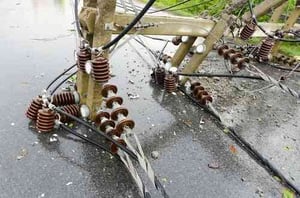Field Asset Services (Part 3): Making Asset Data More Accessible
 In the last post, we discussed the challenges created when asset owners are the only source of information on current field conditions, and the dangers of individual assets being inspected once every decade or less. This situation means it is highly likely no one is aware of the true condition of an asset until a company employee is standing in front of it. Given the commonality of weather events, insect infestations, rot, traffic accidents and unpermitted attachments, chances are that an asset may suffer damage of some kind during the time that passes between inspections.
In the last post, we discussed the challenges created when asset owners are the only source of information on current field conditions, and the dangers of individual assets being inspected once every decade or less. This situation means it is highly likely no one is aware of the true condition of an asset until a company employee is standing in front of it. Given the commonality of weather events, insect infestations, rot, traffic accidents and unpermitted attachments, chances are that an asset may suffer damage of some kind during the time that passes between inspections.
The utility industry has a significant opportunity to improve field safety for line workers and other utility industry employees by more frequently collecting field asset data and from more sources. Further, sharing that data collaboratively with anyone who visits the pole, conduit vault, or other assets could widen the opportunity.
The Power of a Shared, Centralized Asset Database
Example 1: How Crowdsourcing Asset Data Can Help Prevent Injury
The search results show the last inspection date and every inspection the pole has undergone; it shows the asset condition at that time, the names of attachers on the pole, the pole's age, and photographs of the pole. It also shows that one of the attachers visited the pole six months ago and made adjustments to their equipment. At that time, the attacher placed a note in the database that the pole showed signs of potential insect damage. With that information, the line worker tests the pole for insect damage and makes a note to confirm the pole's stability before beginning his work.
The ability for asset owners and attachers to share asset data and collaborate on assets’ maintenance and repairs can be a key tool for ensuring line workers’ safety. Current, accessible data empowers asset owners and attachers to report and act on issues before they become real problems.
Example 2: How Shared Asset Data Minimizes Redundant Work
Three weeks later, an overwhelmed joint use department begins to work on backlogged maintenance requests. Several requests are for tree branches that are interfering with line safety. The vegetation management team is notified by the shared, centralized asset database before heading out for the day. As they confirm each location included in the maintenance requests, they see that one location has already been trimmed. The note states a colleague completed the branch removal three weeks ago while visiting that pole for a different repair. The team removes that work order from their list for the day, pleased to prevent a redundant stop.
These are only two situations in which the ability to collaborate with multiple asset owners and attachers can be a powerful tool for improving safety, saving time and costs, and supporting the strength and reliability of the plant overall.
Some of the benefits of a shared, centralized asset database for owners and attachers:
- Contains the complete history of every asset's life in a single location
- Quickly locates the data needed, using powerful filtering and search functions
- Makes all relevant data accessible in one secure location by connecting multiple, disparate enterprise systems such as GIS, accounting, and workforce management
- Provides complete control over what data to share – and who it should be shared with – within or outside of an organization, customized by user role and business needs
- Ensures that private data is always be kept private
- Presents easy-to-use dashboard summaries and time-sensitive notifications to inform users of past-due permits, pending permits, trespass, violations, and more
Although infighting happens within joint use industries, as in many other industries, at the end of the day all parties have a shared interest in delivering reliable service and ensuring that the infrastructure is maintained and functional. Everyone wants to see issues resolved quickly to ensure a safe environment for their workers, customers, and communities. A shared, centralized asset database is a powerful way to improve the way the industry works together—for the benefit of all. We all work better when we work together.
Can you imagine another situation that would be improved by having access to shared data? We’d love to hear your ideas in the comments.
